Emergency Response and Management Activities, 2014
EPA Cleans Up Abandoned Drum Reconditioning Facility in Gloucester County, NJ
On August 29, 2013, the New Jersey Department of Environmental Protection (NJDEP) requested assistance from EPA in investigating a former drum reconditioning facility in Gloucester County. Within hours, EPA On-Scene Coordinators (OSCs) responded and found thousands of deteriorated and unlabeled containers. Most of them were 275-gallon totes and 55-gallon drums located along a public road and in the woods, wetlands, and elsewhere throughout the unsecured property.
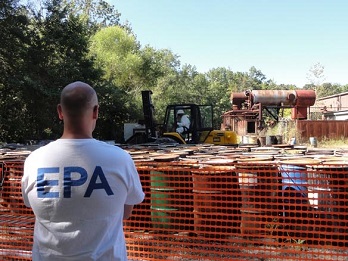
Containers were stacked several high in multiple locations with many leaking, bulging, rusting, or missing tops. Others were damaged by gunshots, placed on their sides, or stored improperly in open and damaged trailers. The OSCs used thermal imagery to determine the majority of the containers were full. EPA obtained a warrant to assess the site after the property owner refused access and collected soil and surface water samples. Material from approximately 250 containers was also collected.
Results indicated that many of the drums contained hazardous materials, including flammable, corrosive and oxidizing liquids as well as cancer-causing volatile organic compounds. To protect the public, EPA provided:
- 24-hour security guards,
- repackaged leaking containers,
- installed fencing along the public road and protective berms, and
- monitored the air quality of the site.
EPA also set up an on-site laboratory and sampled more than 2,100 containers to determine their contents. EPA and its mobile Portable High-throughput Integrated Laboratory Identification System (PHILIS) laboratories were used to conduct off-site analysis of materials. Similar materials were grouped for off-site transport and disposed by September 2014.
EPA Cleans Up Oil that Threatens Wildlife Area in North Dakota
Flooding from melting ice dams damaged an oil well pad that sent more than 170 barrels of crude oil into the waters of the Yellowstone River in March 2014. The oil threatened multiple endangered species in the Big Oxbow wildlife area in North Dakota, including the pallid sturgeon, piping plover and least tern.
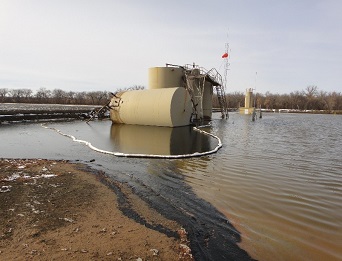
As the ice melted, the well pad became inundated by rising water. The water lifted a tank and broke a valve, destroying connected piping. One of the well pad’s berms failed, releasing the oil and sending a plume of petroleum toward the point where the Yellowstone meets the Missouri River.
Frigid temperatures and heavy snow presented problems getting to the site. The Big Oxbow is only accessible by boat, and an EPA On-Scene Coordinator (OSC) and State OSC had to navigate around icebergs. Motorized vehicles were not allowed on the island wildlife area, so the entire response had to be conducted by boat or on foot.
Under EPA and State direction, the oil company’s contractors deployed boom to prevent spread of the oil, and they removed heavily-stained vegetation. A bathtub ring of crude oil was cleaned from the Big Oxbow embankments and more oil was recovered downriver.
One of the biggest concerns was that clean up needed to be finished before the pallid sturgeon spawning season began, and the birds returned to Big Oxbow for nesting. The cleanup was completed by early May in time for spawning and for a local paddlefish tournament to kick off uninterrupted.
EPA Removes More than 3,000 Containers of Chemicals from House in Seattle, WA
In March 2014, EPA Region 10 was notified by the Seattle Fire Department about a residence in Green Lake neighborhood with a large amount of improperly stored chemicals. The house was occupied by an elderly former research chemist and his sister. Numerous containers of chemicals were stored improperly inside the home and in the yard.

An EPA team, including two On-Scene Coordinators (OSCs), was sent to deal with the chemicals. Preparation included:
- obtaining of an administrative warrant,
- coordinating entry into the home with the US Marshals Service, and
- coordinating with the local fire department.
Cleanup activities took nine days. The response presented many challenges, including:
- relocating the residents during cleanup,
- removing highly dangerous substances in a densely-populated neighborhood, and
- obtaining sufficient labor with very short notice.
EPA, the Washington Department of Ecology, and the Washington National Guard analyzed, categorized, and removed more than 3,600 containers of chemicals, more than 2,000 were unlabeled. As many as 25 workers spent more than 2,200 labor hours to assist with chemical removal. Chemicals identified on site included strong acids, oxidizers and reactives. Waste shipped off site included many different types of hazards.
On June 4, 2013, EPA Region 8 responded to state and local requests for assistance in dealing with a massive amount of improperly stored chemicals and debris in a residential area of North Salt Lake, UT.

Hazardous material containers were stored in small enclosures, such as refrigerator boxes, sheds, and recreational vehicle trailers. Not only were the containers deteriorating, but the enclosures were in such poor shape that there were safety concerns that limited an in-depth investigation. Huge amounts of debris on the property also hindered cleanup.
Local responders were not equipped to handle the large number of deteriorating and bulging containers of unknown waste. Assessments were conducted, but a call was made to EPA once they realized that the situation required a larger response.
EPA arrived and began cleanup immediately. Safety was a primary concern for response personnel and nearby residents. The site contained large trailers and storage sheds packed with containers, many of which had deteriorated over time. Other chemicals were stored in the open, and identifying the containers was a challenge. Some containers had missing labels, outside containers had labels that were unreadable, and often incompatible chemicals were stored together.
Containers were sorted into compatible groups or hazardous categories such as flammables, explosives, toxics and corrosives. The containers were re-packaged into large, insulated chemical-resistant drums, so that they could be safely transported. During the cleanup process, some explosive materials were found, and the North Salt Lake City bomb squad removed them safely from the scene.
By the time site cleanup was completed in December 2013, more than 22,000 containers were removed and transported to disposal facilities.
Long-Burning Fire at Tire Recycling Facility Extinguished in Peñuelas, Puerto Rico
On August 21, 2008, a fire broke out at a tire recycling facility operated by Integrated Waste Management (IWM) in Peñuelas, Puerto Rico. The smell of burning tires was noticeable throughout the surrounding community. The fire was partially extinguished, but it continued to smolder for the next several years. After several unsuccessful attempts to extinguish the fire, the Puerto Rico Environmental Control Board (EQB) asked EPA to take over on March 13, 2014.
EPA collected air, soil, and surface water samples and also conducted air monitoring. Two EPA On-Scene Coordinators (OSCs) identified potential hazards involving:
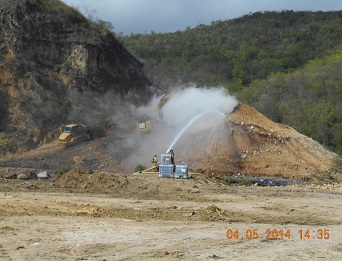
- polycyclic aromatic hydrocarbons,
- benzene,
- butadiene,
- heavy metals,
- pyrolytic oil, and
- semi-volatile organic compounds.
The OSCs determined the best course of action was to dismantle the burning tire pile. EPA developed a work plan with the Puerto Rico EQB, Fire Department (PRFD), Department of Natural and Environmental Resources (PR DNER), and the PR National Guard.
EPA removed and quenched the smoldering material, relocated it to staging areas, and sampled it to determine how best to dispose it. EPA also provided information to the community about the potential dangers of the fire. Puerto Rico EQB conducted air monitoring in the communities and removed the remaining tires. PRFD suppressed the fire, and PR DNER and National Guard supplied equipment for road clearing and creating fire breaks.
After three weeks of work and coordination with Puerto Rico agencies, the fire was officially extinguished on April 24.
EPA Partnership Leads to Groundbreaking Discoveries and Cleaner Drinking Water
A strong partnership between EPA and the Pennsylvania Department of Environmental Protection (PADEP) has helped lead to a new understanding about MTBE (methyl tertiary-butyl ether). At one time, it was believed that MTBE contamination could not be removed from groundwater, but new information developed by EPA and PADEP has developed a promising fix.
The partnership began when PADEP requested EPA assistance to address the contamination of private drinking water wells in Lehman Township, PA. The drinking water wells contained MTBE and another contaminant known as BTEX (benzene, toluene, ethylbenzene, and xylenes). MTBE and BTEX are gasoline additives.
The pollution source was not initially clear, but an EPA investigation determined that both contaminants came from a leaking underground storage tank at a gas station in the area. The investigation also showed that MTBE-contaminated groundwater travelled ahead of the BTEX contamination.
This information led to a treatment plan that involved PADEP installing and operating a large scale treatment system that used carbon treatment and air stripping technology. Bacteria and solids were removed from the water using settling tanks and filter presses prior to treatment.
PADEP utilized this process to treat the groundwater for 10 years, and in 2013, EPA monitoring wells confirmed the cleanup of MTBE and BTEX from the groundwater. This was one of the first successful treatments of MTBE in groundwater.
EPA Region 9 Partners with State and Federal Agencies to Clean Up Abandoned Wrecks in Oakland Harbor
In September 2013, EPA led a federal and state effort to address oil and hazardous substances that were released from abandoned wrecks in the Oakland Estuary in Oakland, CA. More than 50 abandoned wrecks and other marine debris were the focus of the clean-up effort, including docks, piers, pilings, and four sunken commercial vessels.
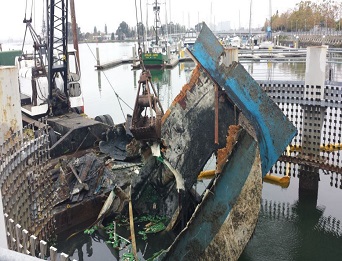
The biggest challenge was getting oil and hazardous material off of sunken vessels. The vessels were evaluated using underwater video, side-scanning sonar, and professional divers to determine if they could be salvaged.
Once the vessels were raised from the water, EPA took the lead on hazardous substance assessment, removal, and disposal. Asbestos, polychlorinated biphenyls, which are known to cause cancer, and heavy metals were detected after samples were taken from the vessels. The State of California handled solid waste disposal and the U.S. Coast Guard was in charge of oil clean up.
Through this partnership, more than 100 tons of hazardous materials were disposed of in March 2014, including:
- Approximately 98 tons of asbestos and waste paint,
- more than 1,000 gallons of flammable liquids and waste oils,
- 160 pounds of acidic and toxic liquids,
- 60 units of expired marine flares and batteries, and
- 1,700 cubic yards of contaminated sediment and debris.
EPA Called to Respond to Colorado's Epic Flood
Heavy rain began falling in Boulder County, Colorado, on September 9, 2013. Over the next five days flooding would claim four lives, knock out bridges, destroy homes and cars, displace thousands of residents, and ravage the Colorado countryside.
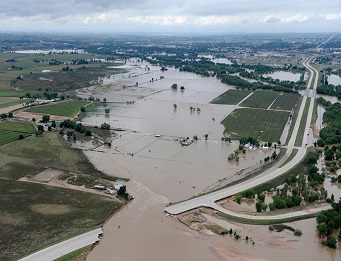
Boulder and Larimer Counties had to reckon with potential leaks from thousands of containers of unknown chemicals. In addition, cars full of oil and gas, refrigerators leaking Freon, and propane tanks dislodged into raging waters had to be managed.
Our first task was to address the hazardous materials releases. On-Scene Coordinators were deployed in helicopters to get aerial views of the two-county area, where they witnessed oil spills and broad devastation. Response crews recovered 35 cars, 329 propane tanks, 259 refrigerators and freezers, 47 batteries, 198 drums, more than 9,000 containers, and many other items.
EPA also had to make sure that flooding didn’t damage two cleanup sites in the Lefthand Creek Watershed, approximately 20 miles northwest of Boulder. The site improvements at Elysian Park Tailings were partially destroyed by raging waters that carved out sections of the main road and sent tailings into James Creek. EPA brought in heavy equipment to restore the channel, armored the banks, and restored the cap.
Further upstream, the storm threatened the second cleanup site where mine tailings lined the banks of James Creek. A previous effort from 2005, stabilized the creek banks with cement pillow armoring, preventing heavy metals-laden mine waste from entering the stream. The armoring endured the floods, but required stabilization and restoration, saving Jamestown from being inundated by an estimated 25,000 cubic yards of mine remnants.
EPA’s repair of these old clean-up sites and its response to the dangerous flooding provided critical support that the counties needed to recover from the storm.
EPA Protects Mississippi Community from Toxic Ricin
In April 2013, letters containing ricin addressed to the President, a Mississippi United States Senator, and a Mississippi county judge were intercepted at a mail handling facility.
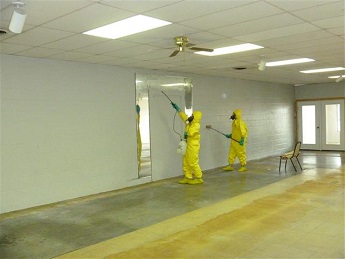
Ricin is a toxin extracted from castor beans. There is no antidote and even small doses can cause severe respiratory distress, lung damage, and death.
The Federal Bureau of Investigation arrested a suspect and found more ricin at a martial arts studio and a trailer house in the Tupelo, Mississippi area. Before those spaces could be re-occupied, the Mississippi Department of Environmental Quality requested assistance from EPA Region 4 to evaluate and decontaminate the locations.
EPA dispatched On-Scene Coordinators (OSC), who drew upon expertise from other EPA OSCs, EPA’s Consequence Management Advisory Team and National Homeland Security Team. EPA’s good relationship with the State of Mississippi enabled effective lab support and fast-tracking of waste disposal. Through these resources, EPA evaluated and completed the decontamination of the locations in only three days.
EPA Tackles Historical Radiation Contamination in Ridgewood, NY
The Wolff-Alport Chemical Company operated a facility in Ridgewood, New York, near the border between Brooklyn and Queens. Around 1940, the company began importing monazite sand, processing it to extract and sell rare elements to various companies. Monazite sand residues contain thorium and uranium, to a lesser degree. The byproducts from these substances were disposed into a nearby sewer, and other wastes might have been buried on the property until the facility closed in 1954.
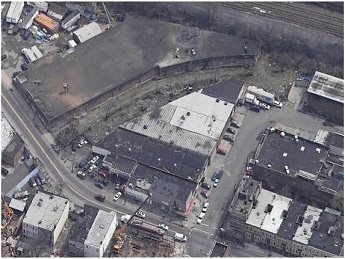
Investigations confirmed surface radiological contamination, as well as radiation inside portions of buildings on the site. Deep soil contamination, thoron gas, and radon gas were also found, and there were indications that contamination had spread off site.
These results prompted EPA to address the health risks of exposure to the radiation. Beginning in 2012, EPA focused on areas with the highest levels of radiation, including a rail spur behind the buildings, spaces inside, and nearby sidewalks and streets. EPA found increased radon levels in one of the businesses and installed a remediation system.
By December 2013, construction of thick raised concrete and lead floors was completed in a warehouse bay and a neighboring auto body shop to protect workers. EPA helped the warehouse and auto body shop owners move and store their equipment to minimize impacts.
Testing was also performed at a nearby daycare center and school, but no heightened radiation was found. The project was completed after a fence was installed around the rail spur and shielding was constructed around the sidewalk outside.
EPA Helps Restore Historic Tribal Site Near Eureka, CA
Indian Island is located in Humboldt Bay near Eureka, CA. Only accessible by boat, the island is historically significant because it was the location of the Tuluwat Village of the
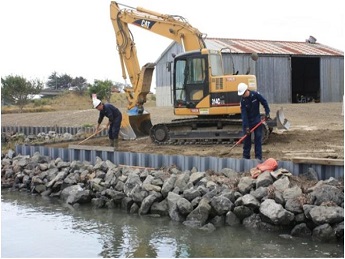
Wiyot Tribe. A six-acre area on the island is made of shells and sand deposited over thousands of years and contains tools, artifacts, and human remains dated to 900 A.D.
The site is also the location of the Wiyot Annual World Renewal Ceremony. The tribe has been unable to resume the historical use of the island since a massacre occurred there in 1860. In 1870, a ship dry dock and repair facility was constructed and operated sporadically through the 1970s. Ships were pulled ashore on steel rails, and a variety of chemical wood preservatives and paints were used.
EPA came to the Tribe’s aid in July 2013 and was granted unprecedented access to the site. EPA then graded and installed a cap to prevent contaminated debris and sediment from entering Humboldt Bay and endangering human health. This allowed the Tribe to begin reconstruction of the site. Now that the contamination threat has been mitigated, the Tribe plans to hold the World Renewal Ceremony in February 2014 for the first time in 150 years. This would not have been possible without the assistance provided by EPA.
Historical Pollution Concerns Spring EPA into Action in Oakland, CA

Lead contamination is a problem affecting many communities across the country. It’s often at its worst in the oldest neighborhoods in urban areas. Communities have been dealing with the legacy of these historical problems for decades. South Prescott in West Oakland is one example of a neighborhood that has dealt with the long-term effects of pollution.
Lead poisoning can cause many symptoms, including abdominal pain, fatigue, difficulty concentrating, and headaches. South Prescott is one of the worst neighborhoods for lead poisoning in Alameda County.
Lead contamination from nearby rail yards, industry, freeways, port activities, and mass transit presented challenges that required an innovative solution. EPA started cleanup efforts by sampling the soil at more than 50 homes and found that 80 percent contained high lead levels.
The next step was to meet with individual residents and community groups to share the findings. EPA worked with the community to develop a cleanup plan that incorporated three goals:
- protect high risk populations from lead contamination;
- minimize impacts to the community and the environment from the cleanup; and
- use local resources, including the talents of local workers, to perform the cleanup.
The plan was a “treat, lock, and cover” cleanup approach that used readily available phosphate to reduce risk of exposure and installing a “green cap.” This was received with great enthusiasm by the residents because it minimized the disruption to their community.
Local workers also got involved in the cleanup after we trained them in hazardous waste cleanup techniques. By the time cleanup was done, EPA addressed contamination at more than at 150 homes.
EPA and Oregon State University Improve Chemical Safety in Labs
In June 2013, EPA responded to a serious threat of release of hazardous substances at several labs at State University (OSU) in Corvallis, Oregon. The problems were discovered by EPA and the Oregon Department of Environmental Quality after a waste compliance inspection. Haphazard storage of very old, dangerous, and unstable chemicals could have
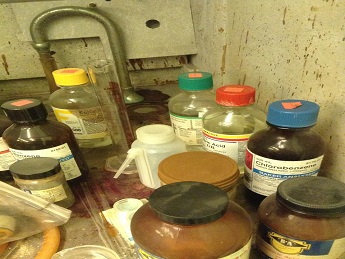
easily caused fire, explosion, health risks, and release of hazardous materials to the environment.
Under EPA direction, OSU began addressing the chemicals and allowed inspection and chemical handling procedures at the laboratories for the first time. Five new lab and safety inspectors were hired, and a chemical audit program was developed for the labs.
EPA’s involvement prompted OSU to address threats to human health and the environment on its campus. It also helped push some fundamental changes, so these kinds of conditions would not occur in the future. CFD thanked EPA for helping to bring important changes and a safer environment for students, faculty, and staff at OSU.

TCE is one of the most common contaminants of groundwater in the United States. It is known to cause cancer, and it has been associated with birth defects and developmental problems in young children. TCE is not only a drinking water hazard, but exposure also occurs through inhalation during common household activities such as showering and bathing.
Within 24 hours of receiving the request, EPA delivered bottled water to residents with impacted water supplies. By September, drinking water samples had been collected for more than 100 homes to determine the extent of the contamination. TCE was present at levels more than 65 times what is considered safe. EPA also installed whole-house water filters at the impacted homes and conducted additional sampling to ensure the filters were working properly.
EPA then collaborated with NCDENR, the county health department, the North Carolina Department of Transportation, and a private water company to find a permanent solution. By June 2013, a community water line was extended to the 22 homes impacted by the contamination.
The success of the project was a direct result of EPA working together with several state agencies and the privately-owned water system. Their support made this government-private partnership work, and resulted in a permanent solution that addressed the potential dangers of TCE in Stony Hill.
